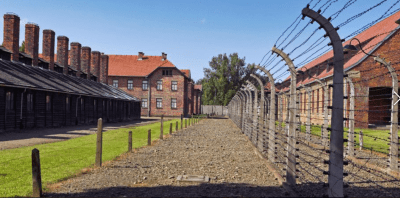Discover Zalipie, a village with over 100 years of floral painting tradition. Travel from Krakow to explore hand-painted houses, fences, and wells. Visit the House of the Female Painters, Felicja Read more ➤
We stand together! Support Ukraine against Russian aggression!
Overview
This name emphasizes the historical significance of Oswiecim, particularly its association with the Auschwitz concentration camp, while also suggesting a reflective and educational experience for visitors. It aims to attract tourists interested in learning about the city's past.
Highlights

Description
Visitors to the Auschwitz-Birkenau Museum, located in Oswiecim, Poland, can expect to encounter a profoundly moving and educational experience that sheds light on one of the darkest chapters in human history. Here's an overview of what visitors can see and experience in the museum:
Auschwitz I: This is the main camp, initially built as a concentration camp for Polish political prisoners. Visitors can explore the original brick barracks, watchtowers, and barbed wire fences that once imprisoned thousands of people. Exhibitions inside the barracks display artifacts, photographs, and documents documenting the history and horrors of the camp.
Auschwitz II-Birkenau: Located just a few kilometers from Auschwitz I, Birkenau was built as an extermination camp and is significantly larger in size. Visitors can see the remains of the gas chambers and crematoria where millions of Jews, Poles, Romani people, and others were murdered as part of the Nazi's genocidal policies. The vastness of the site serves as a stark reminder of the scale of the Holocaust.
Exhibition Galleries: Throughout both Auschwitz I and Birkenau, there are several exhibition galleries housing displays of personal belongings confiscated from prisoners, including shoes, clothing, suitcases, and other everyday items. These artifacts humanize the victims and offer a glimpse into their lives before their incarceration and eventual death.
Memorial and Monuments: Various memorials and monuments are scattered throughout the Auschwitz-Birkenau site, commemorating the victims of the Holocaust and honoring their memory. One of the most iconic is the International Monument to the Victims of Fascism, designed by Polish sculptor Franciszek Duszenko, which features a striking stone monument and railway tracks leading into the distance.
Educational Programs: The museum offers educational programs, guided tours, and lectures to provide visitors with a deeper understanding of the Holocaust, its historical context, and its enduring significance. Educators and guides are available to answer questions, provide insight, and facilitate meaningful discussions.
Overall, a visit to the Auschwitz-Birkenau Museum is a powerful and emotional experience that serves as a reminder of the importance of remembrance, tolerance, and the commitment to never forget the atrocities committed during the Holocaust.
What's included
Itinerary
Morning:
Arrival and Orientation (9:30 AM - 10:00 AM): Meet your guide at the main entrance of Auschwitz I. Begin with a brief introduction to the history of the camp and its significance. Discuss the importance of respectful behavior and solemnity while visiting the museum.
Exploration of Auschwitz I (10:00 AM - 12:30 AM): Enter Auschwitz I and start your guided tour of the exhibitions. Visit the various barracks, where you'll see displays of personal belongings, photographs, and documents documenting the history of the camp. Your guide will provide insights into the daily life of prisoners, the Nazi regime, and the Holocaust.
Visit to the Death Wall and Crematorium (12:30 AM - 13:00 PM): Pay respects at the Death Wall, where thousands of prisoners were executed, and visit the crematorium and gas chamber, where many others met their tragic end.
Lunch Break (1:00 PM - 1:30 PM): Take a break for lunch at a nearby restaurant or café. Use this time to reflect on the morning's experiences and prepare for the afternoon's visit to Auschwitz II-Birkenau.
Afternoon:
Transfer to Auschwitz II-Birkenau (1:30 PM - 1:45 PM): Travel to Auschwitz II-Birkenau, located a short distance from Auschwitz I. During the transfer, your guide will provide additional context about the camp and its role in the Holocaust.
Exploration of Birkenau (1:45 PM - 3:00 PM): Begin your tour of Birkenau by entering through the iconic gatehouse with the railway tracks leading into the camp. Walk along the main thoroughfare, past the remains of barracks, and towards the memorial at the end of the tracks. Your guide will discuss the layout of the camp, the extermination facilities, and the experiences of the prisoners.
Reflection and Memorial (3:00 PM - 4:00 PM): Take some time for personal reflection at the memorial site near the end of the railway tracks. Pay homage to the victims of the Holocaust and consider the significance of your visit.
Conclusion and Departure (4:00 PM - 4:30 PM): Gather with your guide for a final debriefing and discussion. Reflect on the day's experiences, ask any remaining questions, and express your gratitude to the guide. Depart from Auschwitz II-Birkenau with a deeper understanding of the Holocaust and its enduring impact.
This itinerary is designed to provide visitors with a comprehensive and respectful experience at the Auschwitz-Birkenau Museum, allowing time for reflection, learning, and remembrance.
Frequently Asked Questions
How much time does the Auschwitz-Birkenau: A Journey through History and Reflection take?
Auschwitz-Birkenau: A Journey through History and Reflection duration is 4 hours.
Book Auschwitz-Birkenau: A Journey through History and Reflection now just with Booking Deposit on TripsPointHow many days in advance I must book Auschwitz-Birkenau: A Journey through History and Reflection?
You can book Auschwitz-Birkenau: A Journey through History and Reflection at least in 3 days. Check availability calendar in "Book Now" form to see currently available dates.
Book Auschwitz-Birkenau: A Journey through History and Reflection now just with Booking Deposit on TripsPointtraveler reviews
You may also like
Discover Zalipie, a village with over 100 years of floral painting tradition. Travel from Krakow to explore hand-painted houses, fences, and wells. Visit the House of the Female Painters, Felicja Read more ➤